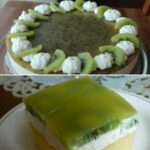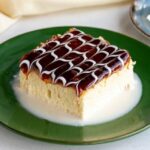
Ingredients:
For the Cake:
- 4 eggs (size M)
- 4 tablespoons ice-cold water
- 200 g sugar
- 120 g flour
- 1 teaspoon baking powder
- 80 g cornstarch
- Neutral cooking oil and a little flour to grease the pan
For the Buttercream:
- 1 packet vanilla pudding powder (for cooking)
- 250 g butter (room temperature, very important!)
- 500 ml milk (for the pudding)
- 50 g sugar (for the pudding)
For Filling & Decoration:
- 1 jar (300 g) raspberry, currant, or sour cherry jelly (or your preferred flavor) + some extra for decorating rosettes
- 1 packet brittle (Krokant)
- 1/2 lemon, sliced (for picking up the brittle)
- Optionally, candied cherries for decoration
Tools:
- Bundt cake pan (∅ 26 cm)
- Piping bag with piping tip (I used Wilton 109)
Preparation:
The Day Before:
1. Prepare the Biscuit Base:
Begin by separating the eggs carefully. Grease and flour the bundt cake pan thoroughly, paying special attention to the central ring—this is crucial for the cake to release properly after baking.
In a large bowl, whisk the egg whites with 4 tablespoons of ice-cold water for about 3 minutes until foamy. Slowly add the sugar while whisking continuously. Once the mixture forms soft peaks, gently fold in the egg yolks until the mixture is smooth and homogeneous.
2. Combine Dry Ingredients:
Sift the flour, baking powder, and cornstarch together. Gradually fold the dry ingredients into the egg mixture. Be careful not to over-mix, as you want to maintain the airiness of the batter.
3. Bake the Biscuit Base:
Preheat the oven to 180°C (350°F) with convection or 180°C (350°F) for top/bottom heat. Fill the prepared bundt pan with the batter and bake for about 25 minutes. Once baked, let the cake cool completely. It is best to do this step the day before, allowing the biscuit to absorb the flavors overnight. After cooling, wrap the cake in plastic wrap to keep it fresh.
4. Prepare the Pudding for the Buttercream:
Cook the vanilla pudding according to the package instructions, using the milk and sugar. Once done, transfer the pudding to a bowl and cover it with plastic wrap. Be sure the wrap touches the surface of the pudding to prevent a skin from forming.
On the Day of Serving:
1. Prepare the Buttercream:
Take the butter out of the fridge and allow it to reach room temperature. This step is crucial for a smooth buttercream. Once at room temperature, beat the butter until creamy and light. Gradually add the pudding (which you prepared the day before), spoonful by spoonful, mixing until the buttercream is smooth and airy.
2. Cut the Biscuit Layers:
Carefully slice the cooled biscuit into two even layers. If you find it difficult to cut evenly, use a cake leveler tool to get a perfect cut.
3. Assemble the Cake:
Spread the jelly evenly over the bottom layer of the cake. Place the second layer of cake on top. Then, spread a layer of buttercream on the top of the cake. Place the final “lid” on top of the cake and coat the entire cake with the remaining buttercream. (Before you finish, fill a piping bag with some of the buttercream for the rosettes later.)
4. Decorate the Cake:
Cover the entire cake with brittle (Krokant). The best way to do this is by pouring the brittle onto a flat plate and gently pressing the cut side of a lemon into the brittle. The lemon will pick up the brittle, which you can then press onto the cake to coat it. This method helps prevent a mess—avoiding the alternative method of “throwing the brittle at the cake,” which could get quite messy in the kitchen!
5. Final Decoration:
Using the piping bag, pipe small rosettes of buttercream around the top edge of the cake. Optionally, you can decorate the rosettes with candied cherries or add a little extra jelly to enhance the appearance.
6. Chill and Serve:
Place the cake in the fridge until serving time to ensure it is cool and firm. When ready, slice and enjoy your beautifully decorated Frankfurter Kranz!
This Frankfurter Kranz is a traditional German cake that is perfect for special occasions, such as birthdays or holidays. The combination of a light and airy biscuit base with rich buttercream and a tangy jelly filling creates a delightful balance of flavors. The crunchy brittle adds texture, and the decorative rosettes provide a sophisticated finishing touch. This cake will undoubtedly impress anyone you serve it to!



